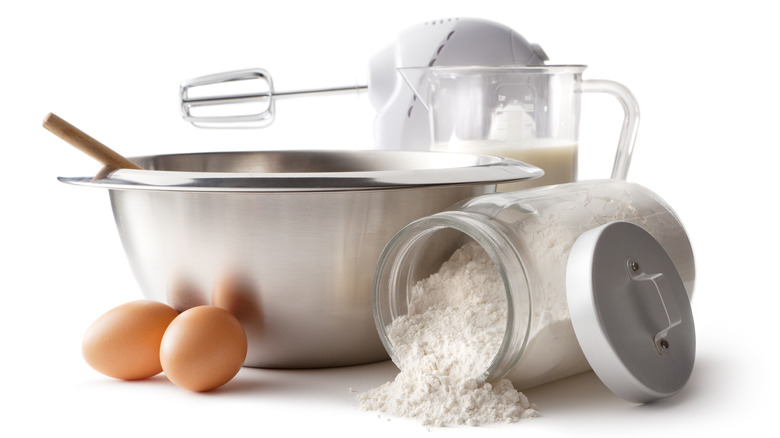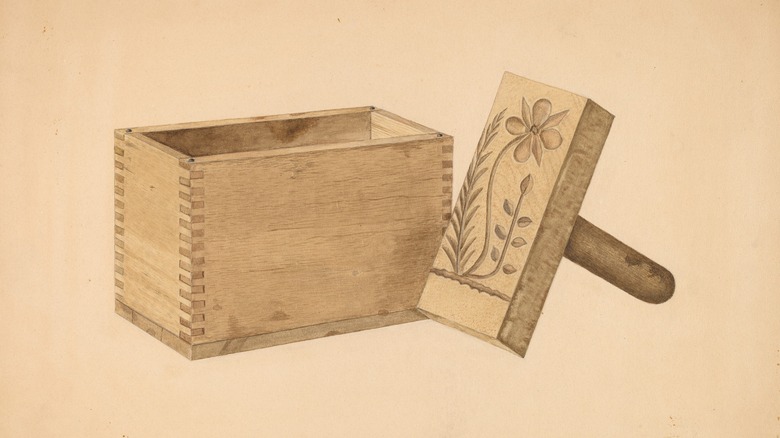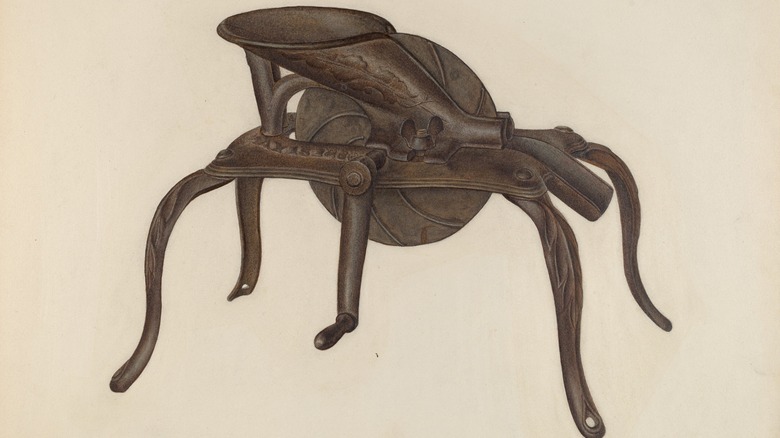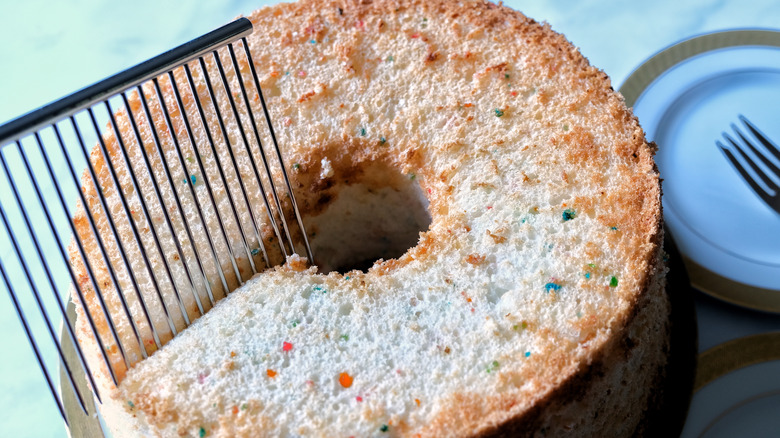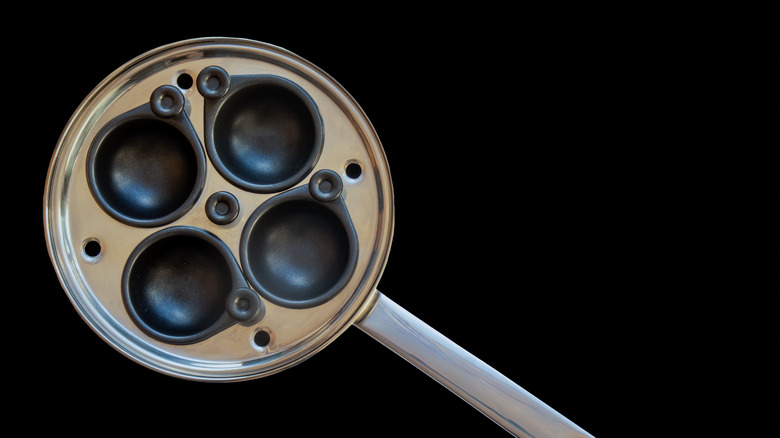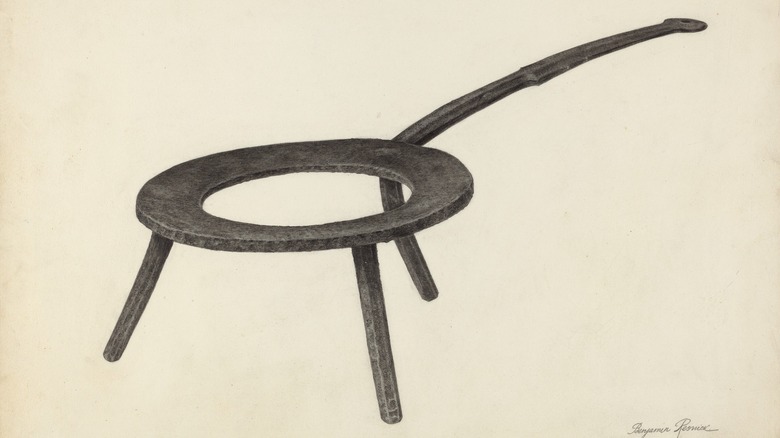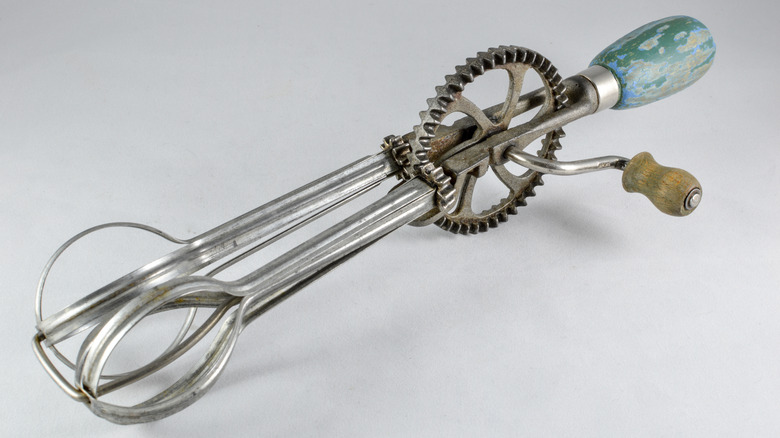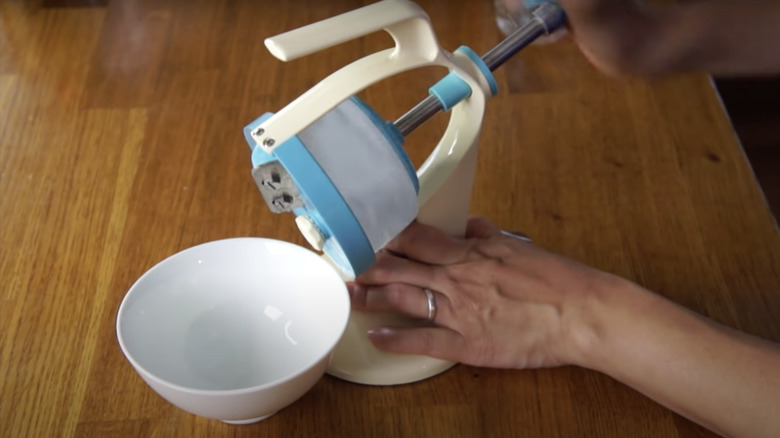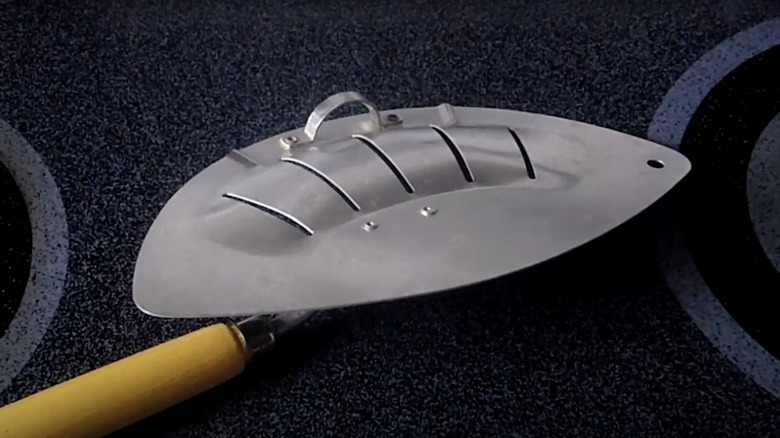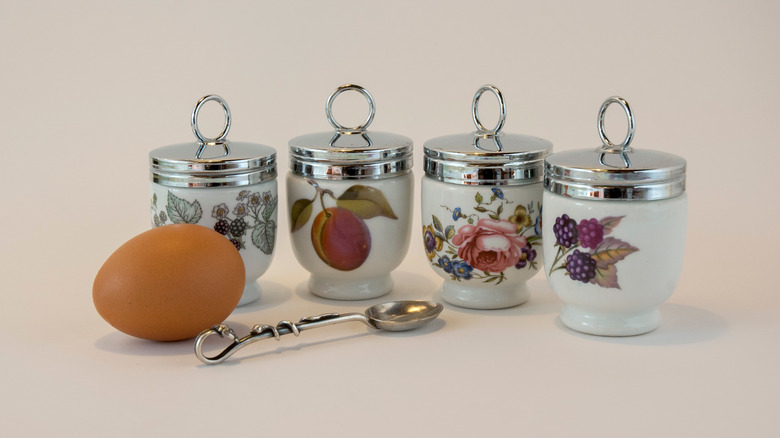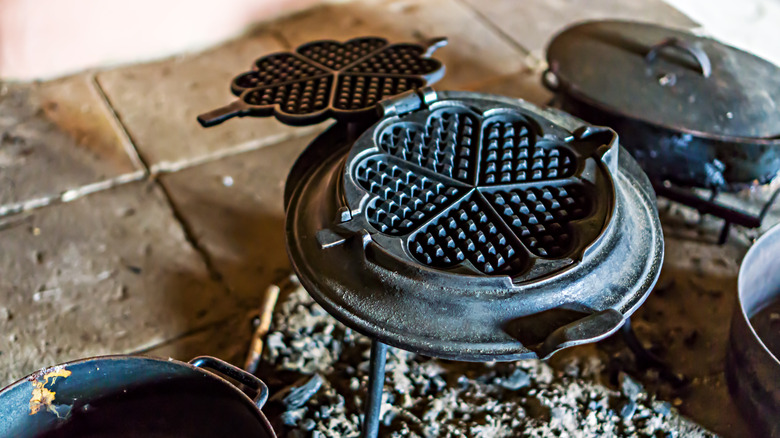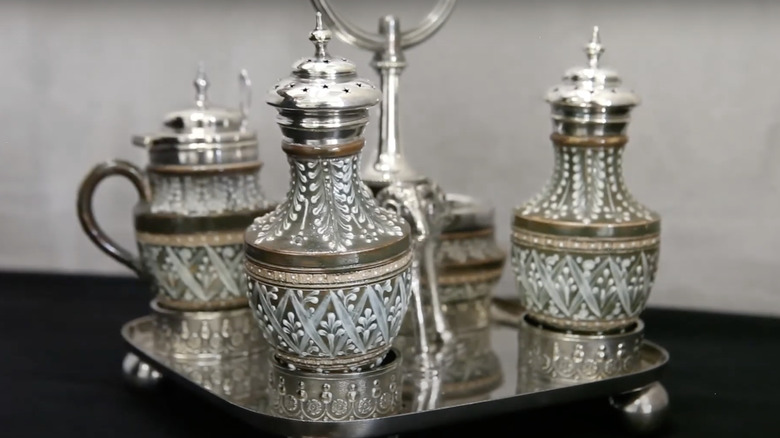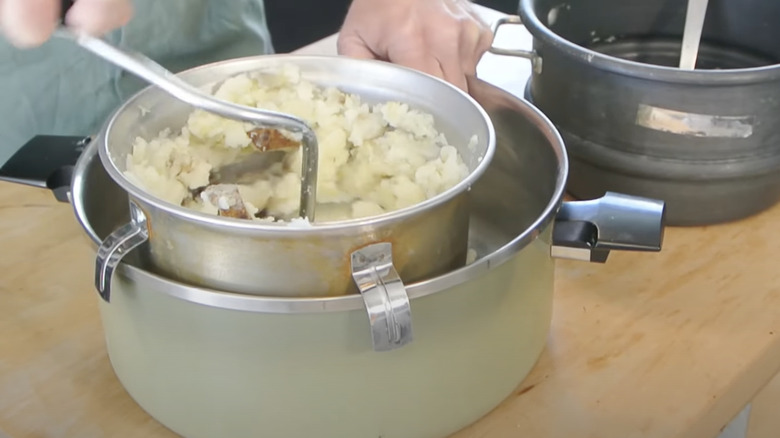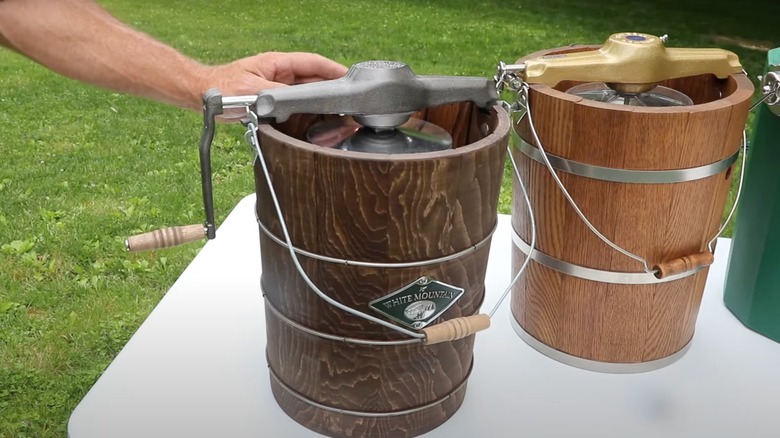14 Old School Kitchen Tools People Don't Use Anymore
The world of kitchen tools is wild and wonderful. Kitchen cookware was first employed way back in the Stone Age, when wood, stone, and clay-based items like pestles, mortars, and griddles were commonly used to rustle up meals. Later down the line, clay pots were invented, which opened up a whole new world of cooking. Bronze, copper, and cast iron kitchen tools followed, establishing the standard for cookware that we still use today.
It's in the modern age, though, that things got truly wacky. As more sophisticated ideas and culinary practices came into play, kitchen tools started to be invented for virtually every function imaginable, from pitting cherries to serving condiments. As time went on and electricity became king, a lot of these tools were phased out in favor of more technologically advanced versions — and elsewhere, certain kitchen tools started to simply fall out of style and be seen as kitsch or retro. We want to shine a light on these amazing items that acted as precursors to our modern appliances by taking a deep-dive back in time. From trivets to egg coddlers, these are the kitchen tools that your grandma might have loved, but we don't use anymore.
1. Cookie presses
Although some packaged cookies might still come in uniform, identical shapes, modern homemade cookies tend to look a lot more rustic and hand-crafted. There was a time when that wasn't always the case, though. Cookie presses (also known as cookie guns) used to be all the rage back in the mid-20th century, with Wisconsin-based company Mirro introducing one into its product line in the 1930s.
These machines, which look kind of like a ray gun, are operated by loading cookie dough into the central canister, then pulling a trigger to squeeze out portions. A disk on the edge of the press gives each piece of dough an intricate shape, making these tools perfect for making spritz cookies. If you have a hankering to try out this old-school tool, you're in luck — although they're not as commonly available today, companies like Wilton and Kuhn Rikon still make models.
Bear in mind, though, that cookie presses aren't compatible with every type of dough; they require something softer and more pliable to be used effectively. They also need a smooth dough, instead of one with chunks of additional ingredients like chocolate chips or nuts, as this can get in the way of each cookie being shaped.
2. Butter molds
Shaped butter is still a thing in some restaurants, but when it comes to home kitchens, it's largely fallen out of fashion. With that, the butter mold fell out of fashion too. Butter molds evolved during the 18th and 19th centuries when dairy farmers would use molds or prints to give their products all-important visual appeal. This practice wasn't purely aesthetic, though — it also helped customers figure out which butter was made by which farmer, allowing them to develop customer loyalty. The farmers packed the pliable butter into the molds before releasing them and sending them on their way, or molded the top of their butter with a stamp.
Butter molds were also made to mark occasions or celebrate individuals, and were often adorned with initials. These molds could vary from simple shapes to extravagant designs, allowing butter shaping to become an art in its own right. With the rise of mass-produced dairy and a more time-pressed population, though, butter molding became a way more niche exercise. That said, there has been a minor revival in interest in butter molds; vintage molds have become a collector's item, common in antique circles and at flea markets.
3. Cherry pitters
The cherry pitter has to be one of the most entertaining kitchen tools ever invented. These tools, as you might have guessed, pull the pits out of cherries using an automated process, allowing you to avoid having to fiddle around with your knife. Operating with hand-crank technology, these fairly large, fairly daunting-looking machines were first clamped onto the side of your table or worktop. Each cherry was fed into a hopper on top of the machine. As you turned the crank, the pit was extracted, and the pit and cherry fell in different directions. This process could make creating homemade cherry-based treats way quicker.
So why does no one use cherry pitters anymore? Well, it's a little hard to justify having such a large tool in your kitchen for a relatively minor task. Pitted cherries have also become way more widely available, removing the need to de-pit them at home. If you do fancy grabbing a cherry pitter, though, you can find smaller, handheld versions out there nowadays. These tools don't just remove cherry pits, but olive pits too, and can do so with a mere squeeze of the hand.
4. Cake breakers
Fans of angel food cake are well aware of the tragedy of smooshing up your perfect bake with a too-blunt knife. So what if we told you that there's a tool out there that no one uses anymore that was specifically invented to prevent this? Cake breakers were invented in the early 1930s, and for a time, they were pretty popular. These strange-looking baking tools look like very large combs, with large, sharp, widely-spaced tines. It's these tines that helped prevent them from destroying cakes' delicate crumb. Users simply sank their cake breaker into the cake, and the spikes separated each slice easily.
While cake breakers have fallen out of favor with the general population, they still exist in various forms. Angel food combs, for example, are still pretty widely available, and are used by many professional bakers. Other tools, like wire cake levelers, have also emerged as a way to get perfect slices without any cake rubble or icing smears. In modern kitchens, however, cake breakers have been largely edged out by super-sharp knives, which can kind of do the same job without taking up valuable drawer space.
5. Egg poacher pans
Eggs have to be one of the most versatile foods out there. Not all egg-cooking methods are as easy as others, though, which is probably why egg poacher pans were once popular.
It's unclear exactly when these pans were invented, although a patent was filed in 1937 for their invention by William F. Serr, and its drawings look pretty similar to subsequent models. These tools consist, essentially, of one big pan containing lots of mini-pans, which were suspended and separated by a removable metal attachment. Simmering water was added to the big pan, and the mini-pans, greased with butter and containing a cracked egg, were popped in. The simmering water then gently cooked the eggs from underneath, producing a bunch of poached eggs quickly and easily.
These pans have largely become obsolete, perhaps because people have gotten better in the kitchen and figured out that you can make perfect poached eggs using just a big pan of water, some vinegar, and a little technique. Importantly, though, poached egg pans never disappeared, and are still available online. In our personal view, they should make a comeback — we're kind of sick of ruining our poached eggs over here.
6. Iron trivets
Iron trivets are essentially large, shaped pieces of iron that functioned as a stand and were used around the home to keep things warm. The earliest trivets were made during the prehistoric era, and the tool remained popular in homes throughout the pre-electricity days. These unique tools kept pots slowly bubbling on the stovetop, maintained pressing irons' heat, and gave sundry other household items a resting place between uses. Some were made from ceramics or wood, especially in areas where iron wasn't available.
Nowadays, you'll still find trivets here and there, but they're more commonly used as decoration or a stand for pots instead of active parts of the cooking and heating processes. As modern technology rolled on, making it easier to control temperatures on stoves and keep things warm, trivets lost most of their original purpose. They do, however, still make nice ornaments, and can be super useful when cooking outside or away from the conveniences of a kitchen.
7. Hand mixers
Before the stand mixer, there was the hand mixer. These kitchen tools are among the most iconic utensils out there, and for a time, they provided a vital function for various foods. Hand mixers were first invented in the mid-19th century, and operated via a hand crank connected to a gear, which in turn connected to a set of beaters. To operate the machine, cooks held the end of the hand mixer with one hand, and used the other to turn the crank, which rotated the beaters and whipped up whatever was being cooked.
These tools evolved to incorporate more ergonomic designs, with specific types of mixers like egg mixers becoming common. Then, inevitably, technology changed everything. Once electricity started to become mainstream, electric hand mixers were invented, taking the effort out of using these tools. Stand mixers also started to become more prominent, eliminating the use of any arm action. These days, you can still find manual hand mixers out there, usually at a much cheaper price than their electric versions, but their once-intricate designs have been replaced by more functional, ergonomic models.
8. Ice pets
If there was a competition for the cutest-named kitchen tool, ice pets would win. These appliances, however, weren't the kind of pets you feed and name. Instead, ice pets' sole function was to shave ice down to small sizes, which were then packed into snow cones. To operate these, users loaded a disk of ice into the barrel of the ice pet, then turned a hand crank on the end, which operated a sharp blade. This blade skimmed shavings of ice off the disk, creating a snow-like consistency.
Although we appreciate this unique way of making shaved ice, we can sort of understand why they're no longer popular. For one thing, ice pets were pretty loud; the scraping of the blade on the ice caused a din in the kitchen. They were also slightly hampered by the need for a disk of ice, which required a specific mold. In truth, though, the need for ice pets was most prominently removed by the rise of food processors and blenders, both of which reduce ice to tiny shavings without needing it to first be shaped into a disk.
9. Metal pot strainers
Strainers are one of the most important kitchen tools out there, and pretty much everyone has one in their kitchen. However, while one form of strainer, the colander, has persisted since ancient times, another form came and went relatively quickly. This was the metal pot strainer. These strainers, which appear to have been patented in 1947, consisted of a metal plate with slots cut into them. Cooks simply placed the strainer on the side of their pot, then tipped the liquid through the slots as needed, retaining the food inside.
Importantly, pot strainers never really went away — they're still available today, usually in attachable, plastic form, allowing you to clip them onto the side of your pot to strain out pasta water and other such liquids. Arguably, though, colanders have proved way more useful, as they allow you to catch all of your food and get rid of liquid near-instantly. The advent of removable pots that have built-in straining holes has also rendered separate metal strainers obsolete.
10. Egg coddlers
The egg coddler has to be one of the most beautiful kitchen tools around. These objects (which were used — no prizes for guessing — to coddle eggs) came in intricately painted designs and operated as much as a serving utensil as they did a cooking tool.
It's not clear exactly when egg coddlers were invented, or who invented them, but they started to gain popularity in late 19th century Europe. These earthenware objects were like little pots into which eggs were cracked. The coddler was then placed into a pot of boiling water with the lid screwed on. The water proceeded to cook the egg inside.
So, why did egg coddlers stop being popular? It might be because coddling as a form of cooking endured a major decline. Nowadays, you're far more likely to find a poached, fried, or boiled egg than a coddled one, despite how tasty and easy to make they are. Egg coddlers also serve a very specific function, and while they're nice to have around, it's hard to justify making space for them in an already-crowded kitchen. Thanks to the beauty of their designs, though, they make an excellent collector's item or ornamental piece.
11. Handheld waffle irons
Waffle irons have stood the test of time, but the handheld version is little seen these days. For a long time, though, they were very desirable. Waffles have been around in various forms since ancient times, with the plates used to make them found throughout history — often in way more fancy form than the studded design we know today. These early forms of waffle irons were made of metal and attached to two long handles. The cook clamped the iron shut with the batter inside and held it over an open fire until the waffle was cooked.
As time went on, handheld waffle irons got smaller and became stovetop affairs, eliminating the need to constantly hold them. The classic grid shape also became the standard design, as people began to appreciate its ability to hold various toppings and syrups. Electricity, though, changed everything. Once the electric waffle iron was invented, the need for handheld and stovetop versions vanished, and it became an appliance in itself. If you look hard enough in vintage stores, though, you might be able to find the old-school kind.
12. Condiment trays
There's no specific reason we can figure out as to why condiment trays stopped being a thing. After all, condiments didn't exactly fall out of fashion. People just kinda ... don't use them anymore. For a while, though, condiment trays were both popular and intricate. Beautifully designed trays featured lovely landscapes, elaborately geometric patterns, and even full-blown pastoral scenes, dating all the way back to 1750s Germany. More simple designs consisted of small pots placed on a miniature lazy Susan. Certain trays also had different-sized bottles, allowing people to place more commonly used condiments in the larger vessels.
This is all very charming. But condiment trays required a lot of decanting, and were probably also tricky to clean. Moreover, store-bought condiments have become way more common and come in jars or bottles of their very own, saving time and space in your kitchen. It's a shame, though — condiment trays really do provide a touch of elegance to any meal, and serve as a conversation piece in their own right.
13. Food mills
There was a time when every kitchen in the country had a food mill. Although you can still find them today, there's no denying that they're way less popular. The food mill's primary function was to purée food. Invented in the early 1920s, chefs used food mills by placing whatever they wanted to puree in the upper vessel. They then turned a hand crank, which rotated an angled blade, forcing the food through the disk and turning it to a mushy, smooth paste, while simultaneously separating out any seeds and fibers.
Food mills have been largely replaced by electric blenders, which perform the function of the tool in a fraction of the time, but there's still an argument to be made for keeping one in your house. For starters, they produce a way thicker purée than a blender does, as much less air gets into the food. They're also way more environmentally-conscious and can be operated for free, instead of eating into your electricity bill. Above all, though, food mills are a great way to get back in touch with the physical process of making food and to purée in an enjoyably retro manner.
14. Hand-crank ice cream makers
Ice cream has been around for a while, but it wasn't until the hand-crank ice cream maker was invented that it became popular. This kitchen tool was invented by Nancy M. Johnson in the mid-1800s. It turned what used to be a dessert solely available to the upper classes into one the masses could enjoy. These machines operated via a hand crank which turned a paddle, churning the mix into smooth, delicious ice cream. Later in the century, hand crank ice cream makers got smaller. This meant that anyone who could afford one and had the space for it — which was suddenly a much larger group — could make it at home.
However, we can see why people started to opt for the electric version when it became available. Hand crank ice cream makers took a long time to operate, with around 45 minutes of constant cranking required to produce the dessert. Nevertheless, certain companies still produce hand-crank ice cream makers, including White Mountain (who have been producing ice cream makers since the 19th century) and Homeplace Market. For everyone else, though, there are the widely available electrical models.
